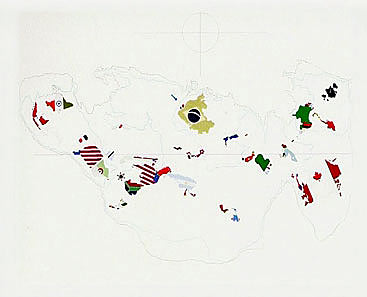
Born in 1967 in Ghent (BE)
Lives and works in Paris (FR)

2003
Animation film, colour, sound
Texte : Abigail Lang
Durée : 8'
Year of Purchase: 2004
first – water – and memory – where land once was
With these simple words (the words of Abigail Lang) we set off on Catharina Van Eetvelde’s amazing cruise – a voyage that offers a poetic look at the overall situation of an orthonormalized world, from the drawing of an imaginary and solitary Pangaea to the retranscription of various data on Belgium, New Zealand or the Holy See.
1300 drawings come to life and make up an 8 minute video in which maps emerge, pieces of land break up, and territories float off. The line is both light and accurate, displaying a scientific rigorousness that can be read first as information and then as outlining a complex narrative. The human event is largely overshadowed by the convention of raw data, topography, demography, economy etc. It is an ambitious project, for as the work runs on the wall on which it is projected, it appears as a rereading of the world through the signs of its mapping. Rather than history, Cruise is geography to take in with the senses.
The geographical map is a semantic system that represents a reality defined in terms of pure information. A self-referential pretence, it synthesizes and models, then articulates specific codes in order to render a defined territory. The map is a set of signs purporting to set a representation of the world in total flatness (the geoid1 is flattened out into a planisphere). This is a clear paradigm of control over space, the instrument of a rationalization process, and thus has a part in the completion of the world: ‘The perfect crime’, writes Baudrillard, ‘is that of an unconditional realization of the world by the actualization of all data, the transformation of all our acts and all events into pure information: in short, the final solution, the resolution of the world ahead of time by the cloning of reality and the extermination of the real by its double2.’ Cruise then is to be seen as a diversion. For in taking over the tool of this death-dealing realization, Catharina Van Eetvelde pulls clear of this will for literal exhaustiveness and takes her subject onto the parcelled ground of the imagination. She diverts mapping codes in order to draw a mental space.
There is no localization by x y z triangulation in her work, the equatorial line serves as a rope onto which drifting territories are anchored. Cartesian coordinates are not enough to place this floating land, towed like a liner into harbour, by a tug/territory flying the Norwegian flag. To the constitution of the world, Catharina Van Eetvelde prefers the assembly of a world. The globe reverts to a kind of seagoing origin. On the expanse of sea, broken up continents are mixed together by the currents. The map no longer has any epicentre, having succumbed to a centripetal force that redefines it as an open surface, a global platform made up of flux. The cartographic problem has fuelled part of 20th-century art history3. From the surrealists to Jasper Johns, and taking in Alighiero e Boetti, it has been at the heart of all kinds of practices. Some¬times it is the backdrop for experimentation in graphics4, at other times an object seen in terms of a plane surface5, or as political symbolization6 … art has disseminated its possible meanings. With Cruise, Catharina Van Eetvelde shows how this rational geography is primarily a metonymical object requiring deconstruction. She then offers a cruise with no planned destination, a paradoxically ‘atopical’ voyage that has shaken off the all-powerful grid of coordinates.
Guillaume Mansart
1 Things to know: The Earth is a geoid close to an ellipsoid of revolution or spheroid flattened at the poles by 1/298.5, which corresponds to a polar radius of 6356.752 km, roughly 21 km shorter than the equatorial radius, equal to 6378.136 km.
2 Jean Baudrillard, The Perfect Crime, Verso, London, 1996.
3 On this, see: Christine Buci-Glucksmann, L’œil cartographique de l’art, Galilée, Paris, 1996.
4 Max Ernst redrawing the bends of the Loire as a woman’s curves.
5 Jasper Johns taking the map of the United States as a plan image.
6 Alighiero e Boetti’s embroideries of maps found on newspaper front pages.